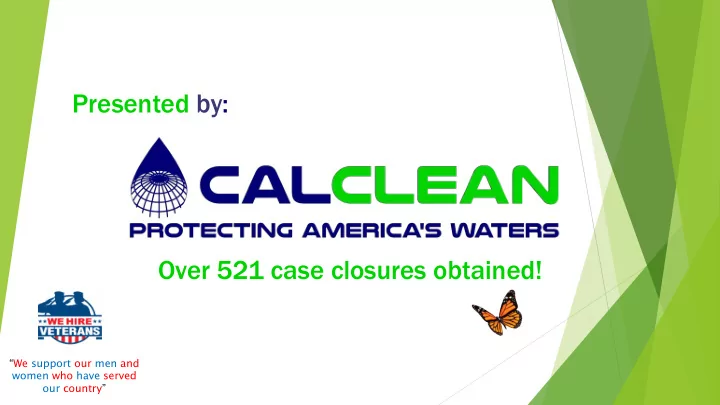

Presented by: Over 521 case closures obtained! “We support our men and women who have served our country”
is Ready to Clean Up Missouri
Agenda 1) Petroleum Storage Tank Insurance Fund (PSTIF) 2) CalClean's #1 Priority – Working as a TEAM to get site closures 3) How HVDPE works - Technology 4) Capabilities: i) Petroleum Hydrocarbons ii) Chlorinated Hydrocarbons iii) Oil Fields 5) Enhanced Remediation Techniques - PSH Removal 6) Effective use of DPE – Overcoming Operational Challenges 7) Carbon Footprint 8) Contracting Options 9) Kennett Conoco, Missouri (Case Study) 10) Overview
Implementing the Petroleum Storage Tank Insurance Fund(PSTIF) The purpose of the Missouri Underground Storage Tank (UST) Program PSTIF , is to ensure that Underground Storage Tanks (USTs) containing petroleum products are managed in accordance with federal and state laws and regulations. is ready to assist with 1. Protecting the drinking water of Missouri 2. Managing the assessment and remediation of contaminated sites 3. Providing the most cost effective and efficient services
CalClean’s #1 Priority Working as a TEAM to get site closures CalClean staff worked City of Blythe had the largest safely to obtain this goal commingled plumes in the USA! and wear their hard hat In 5 years, CalClean closed 6 of sticker with pride. the 7 plumes!
High Vacuum Dual-Phase Extraction (HVDPE) Truck-Mounted Systems Mobile Trucks are mounted with: •450-CFM High Vacuum Systems and •25 hp Liquid Ring Pumps (LRP) Dimensions : 8 ft. Wide (12 ft. When Onsite and Open) 35 ft. Length
Equipment has been rated <55 dBA
Extraction Process
Flow Diagram
Vapor and Groundwater Extraction Cone of Depression * TIMING FOR ILLUSTRATIVE PURPOSES ONLY (Longer Events usually increase Cone of Depression and expose more saturated zone for vapor extraction)
Plume Size: CalClean DPE vs Months of Installing a Fixed Based Unit Installation of a Fixed Based Unit Cone of Depression DPE Months
Capabilities Petroleum Chlorinated Oil Fields Hydrocarbons Hydrocarbons High Vacuum Systems for Fleet of truck-mounted 450- Fleet of trailer-mounted extraction of oil at oil field CFM High Vacuum Systems 20-hp Chlorinated Systems sites with 25-hp LRPs and trailer- (Carbon) mounted 10/20-hp LRPs High Vacuum Systems Fleet of Trailer-mounted 20-GPM Groundwater Treatment Systems With truck-mounted extraction and water treatment systems staged throughout the USA, we are ready to mobilize within 1-2 days! States with stored equipment
Enhanced Remediation Techniques and PSH Removal 1. Use Air Sparging to enhance HVDPE 2. Use HVDPE to remove diesel free product and similar liquids 3. Introduce Surfactants to assist with diesel cleanups 4. Clean up contaminated vadose only sites quickly with high vacuum systems 5. New well box and underground piping design for HVDPE operations 6. Use periodic extractions (w/interruptible pricing) to address rebound
Overcoming Operational Challenges Outdoor weather Security and On-Site Traffic 1. Rain 2. Snow 3. Cold 4. Heat 5. Wind
Contracting Options T & M Basis: Performance Based Contracts (PBC): 1. Cost per day 1. Reduces Overall Project Costs 2. Standard Rate Schedule 2. Quicker Cleanups – Can Use Multiple Systems (see www.calclean.com) 3. Better For the Environment a. Guaranteed Results b. Cutting Edge Technology Used 4. States Moving Toward PBC/PFP a. Lowers Administrative Costs 1. The State of Florida has seen a 64% savings b. Funds Easier to Control 5. Risk Transferred to Contractor Versus Agency
A carbon footprint is historically defined as the total set of greenhouse gas emissions caused by an individual, event, organization, or product, expressed as carbon dioxide equivalent. Source: Wikipedia has reduced the company carbon footprint by 82% by manufacturing all remediation equipment using solar power! We are currently working on technology to reduce the carbon footprint once onsite during remediation Protecting America’s Waters and Reducing Carbon Footprint one step at a time
Kennett Conoco, Missouri (Case Study) 1. June 2015, PSH >3 ft. in 16 wells onsite and offsite on 4 properties 2. MTBE affected city drinking water wells ½ mile from site – wells are shut down 3. Lithology consists of sand with some silt 4. CalClean utilized 4 powerful HVDPE systems simultaneously to extract from multiple wells onsite and offsite 5. All PSH removed within ~4 months of operation 6. 5 air sparge wells were added after PSH was removed, which increased mass removal rates 7. Approximately 402,616 lbs (~64,444 gallons) of vapor-phase gasoline was removed in ~21 months of operation (as of 3/31/2017) 8. 5.99 million gallons of groundwater was removed in ~21 months, reducing dissolved groundwater concentrations to well below DTLs/RBTLs for all onsite wells 9. All equipment currently shut down for Plume Stability Analysis
Approximate cost for cleanup At Kennett Conoco (06/2015-03/2017) ~$2 per lb. HC
Kennett Conoco, Missouri (Case Study) Former Kennett Conoco Station
Overview 1. Storage HUB near Kansas City with three truck-mounted systems ready for work in Missouri (and other states)! 2. We can use multiple systems to expedite cleanups (PBCs) 3. Our patent-pending technology has obtained the most number of case closures in the USA 4. We can perform under T&M, but we prefer PBCs/PFPs 5. Our safety record is arguably the best in the country! 6. Our systems are “neighborhood” quiet 7. We wish success for Missouri (and other states) and will work closely with consultants to obtain case closures
Meet the Team
Recommend
More recommend